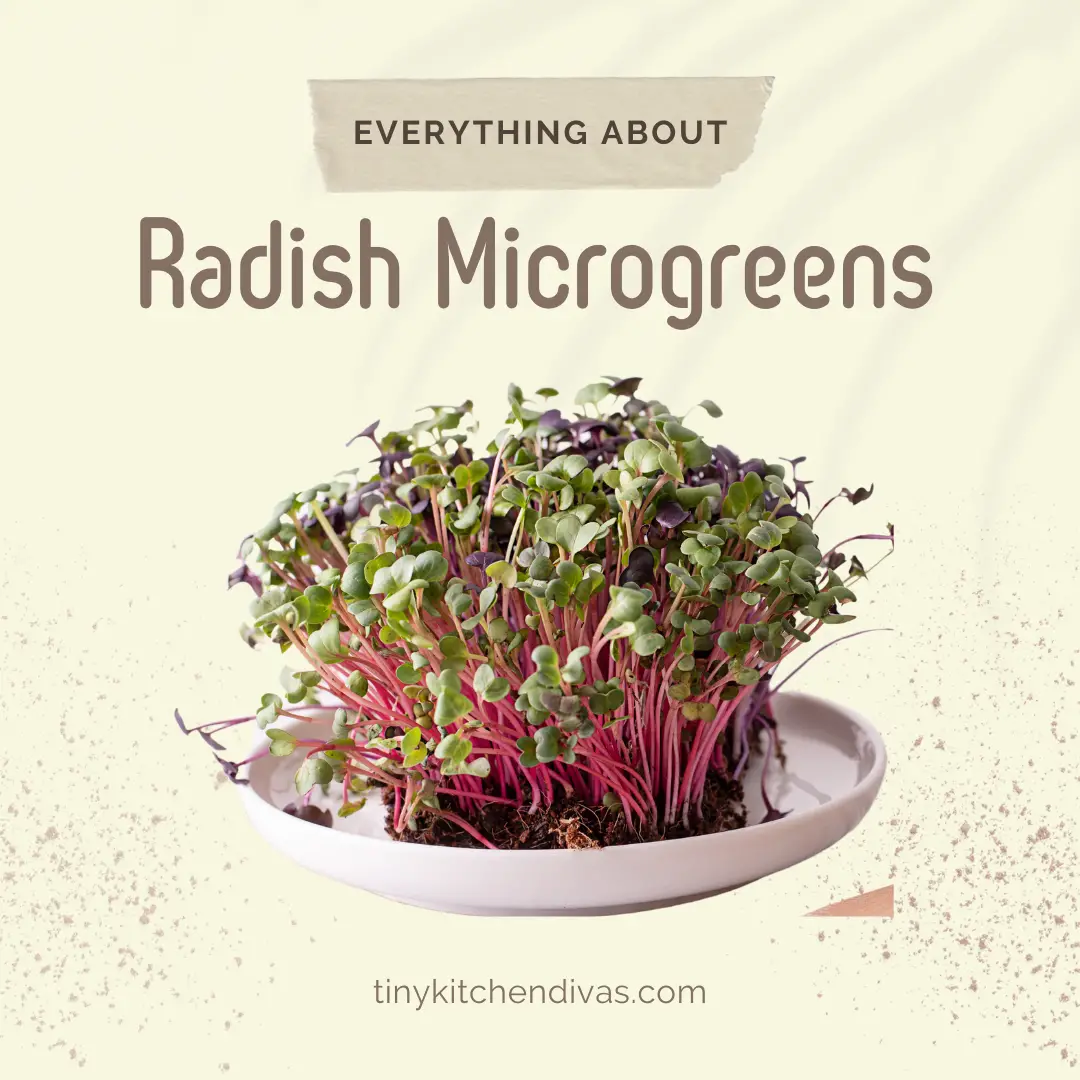Microgreens are small green vegetable plants, about 2.5 to 7.5 cm tall. They are rich in valuable nutrients and are enriched with aromatic flavor. Microgreens are available in a variety of colors and textures.
The seeds used to grow microgreens belong to the family Brassicaceae. Radish microgreens are the most popular of all microgreens. The popularity of radish microgreens is attributed to their crunchy texture, spiciness, and fresh flavor. In addition, radish microgreens contain vital nutrients and vitamins in abundance. Radish microgreens can be grown at home in a short time.
Nutritional Value of Radish Microgreens
Radish microgreens are rich in vitamin B3, vitamin B6, vitamin C, folate, and traces of minerals like manganese, iron, potassium, calcium, magnesium, zinc, and pantothenic acid. They also contain vitamins A, K, and E.
Radish microgreens are an excellent source of manganese, providing 0.3 mcg or 13% of the recommended dietary allowance. The human body stores about 20 mg of manganese in the bones, liver, kidneys, and pancreas. So, it is essential to obtain sufficient manganese through our diet.
Manganese helps in the proper functioning of the nervous system and assists in activating the enzymes required for metabolic processes. It also helps develop bones, reduces inflammation, and controls sugar levels.
Radish microgreens deliver around 113 mg of phosphorus, which is 11% of the recommended phosphorus levels in the diet. Phosphorus helps filter waste products from the body, manufacture the nucleic acids in the body, and repair tissue and cells.
Calcium is also present in abundance in radish microgreens. About 5% of the recommended levels of calcium are present in the microgreens. Calcium can help in the development of muscle, blood circulation, and nerve conduction.
About 70% of the body’s iron is present in red blood cells and muscle cells. The deficiency of iron can cause anemia. Radish microgreens contain around 0.6 mg of zinc. Zinc helps manufacture enzymes that perform several body functions like cell division, development of bone, immune cell function, signaling, and wound repair.
Microgreens contain around 0.1 mg of copper. Copper is essential for proper neurological, musculoskeletal, and cardiovascular functions.
Health Benefits of Radish Microgreens
Radish microgreens contain essential amino acids to enable the body to conduct critical life processes, including energy regulation, enzymatic functioning, tissue growth, and repair, and are absolutely full of calcium.
Although radish microgreens are rich in nutrients, they should not be consumed by people with iodine deficiency, as too much iodine can block the proper functioning of the thyroid gland.
Vitamin B6 and folate help in improving cardiovascular health by breaking down homocysteine. Homocysteine is responsible for depositing fats in the blood vessels and plays a role in causing heart attack and brain hemorrhage. The glucosinolate content of radish microgreens makes it a better anticancer food than broccoli.
Radish microgreens also help in weight reduction. As the radish microgreens have significantly fewer calories and are rich in vitamin C, these microgreens help in the fat-burning process. Not only that, radish microgreens help fulfill the body’s energy requirement. Vitamin C helps build collagen for the operation of wound repair and maintaining strong blood vessels.
Isothiocyanates present in radish protect against the formation of tumors and cleanse the body of harmful cancer-causing compounds. Furthermore, radish microgreens help maintain glowing skin. The skin is constantly exposed to free radicals, medicines, pollution, toxins, and UV rays. The vitamin C in radish microgreens helps counter the oxidative stress on the skin and makes it look healthy and glowing.
Antioxidant-rich components of the microgreens like polyphenols reduce the risk of Alzheimer’s disease. These antioxidants reduce inflammation throughout the body and protect against diseases like arthritis. Moreover, these components reduce the stress on the body’s cells and increase glucose uptake by cells by 25-44 percent, thus reducing the risk of diabetes.
The fiber in these microgreens promotes healthy bowel movements, relieving problems like constipation, bloating, gas, and indigestion.
Varieties of Radish Microgreens
Radish microgreens come in a variety of colors and cultivars, just like radishes. Therefore, microgreens are a great way to add color, depth, and flavor dimensions to the dishes. China rose radish, daikon radish, minnows radish, red Rambo, and purple radish are some of the most common radishes available in the market.
How are Microgreens Different from Mature Vegetables?
Research has proved that microgreens provide approximately four to six times the nutrients in mature vegetables or greens. Nutritional benefits differ significantly in different microgreens types. For example, daikon radish microgreens contain the highest levels of vitamin E.
Why Should You Consume Radish Microgreens?
The US Department of Health and Human Services and the US Department of Agriculture have released dietary guidelines for 2015-2020. These state that people should consume 1-4 cups of vegetables daily, depending on age. Microgreens provide a significant percentage of health-promoting nutrients than their mature counterparts. They also offer more medicinal benefits. As microgreens cover both criteria, they can be easily grown at home for regular consumption.
Conclusion
Choosing a healthy lifestyle for yourself and your family may seem like a huge challenge, but microgreens are a great way to start. One may grow microgreens in the kitchen or terrace garden throughout the year. Although they have different times to harvest, they are worth the wait.
Microgreens may be smaller in size, but they are enriched with many nutrients and are safe for all age groups. One of the most important things about microgreens is that they should be eaten fresh. They can be stored. But after harvesting, they should be consumed within two days.
References
McDermott, A. (2016, May 17). Are radishes good for you? Healthline. https://www.healthline.com/health/food-nutrition/the-benefits-of-radishes
Tesolin, J. (2020, May 28). What are microgreens: A guide to tiny greens big on nutrients + 5 recipes. RusticWise; rusticwise.com. https://rusticwise.com/what-are-microgreens/


